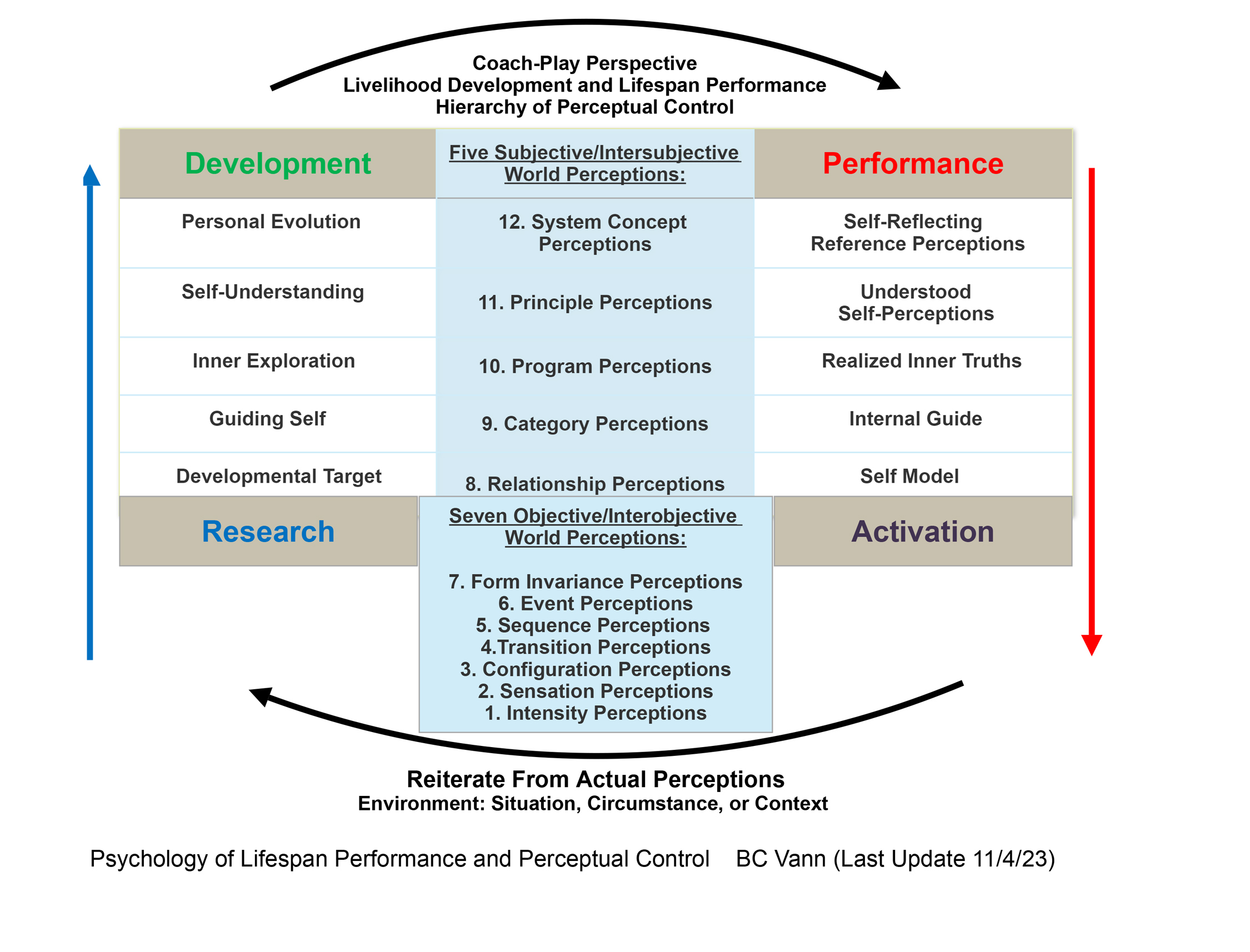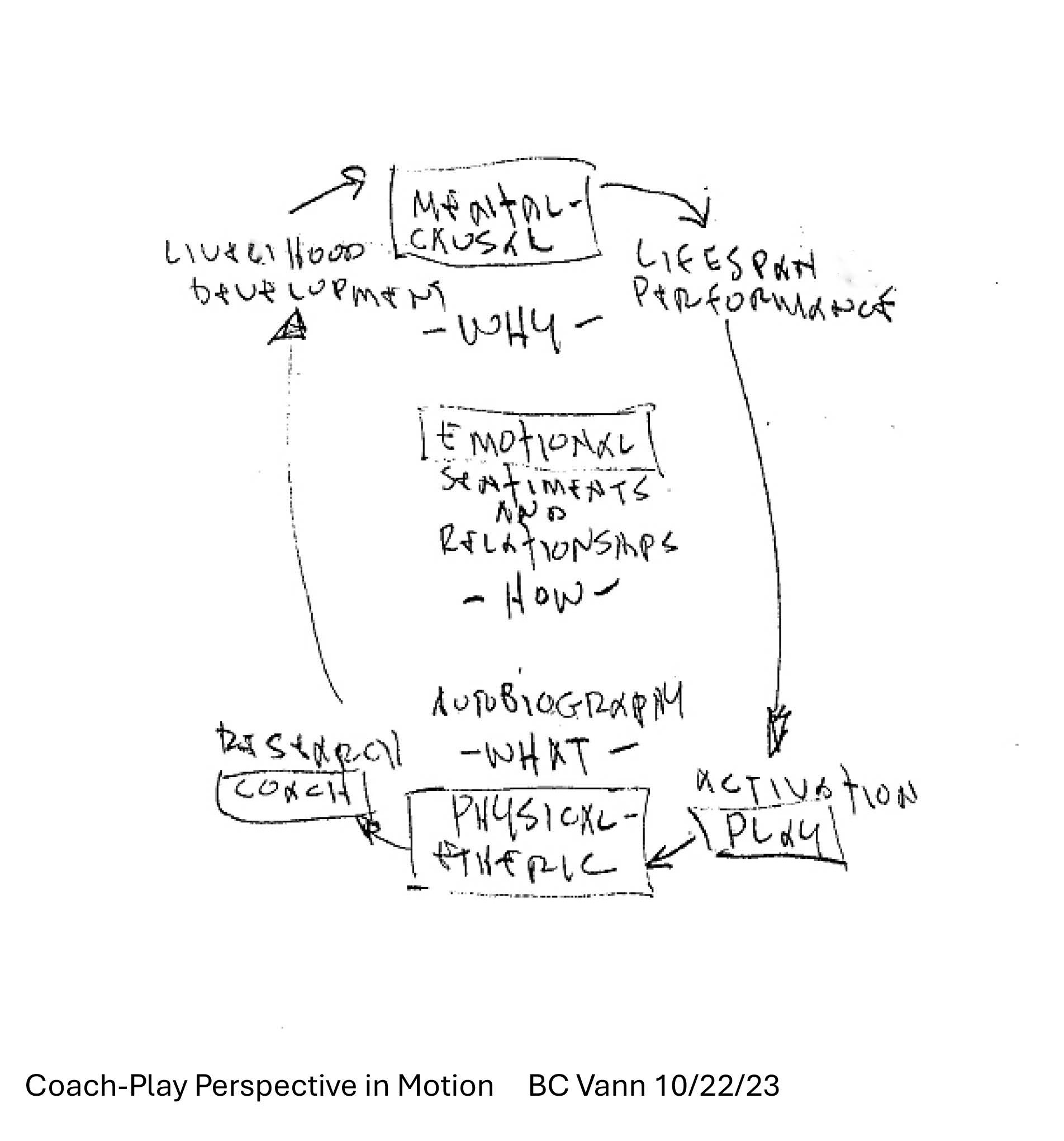As Your Resource For Self-Development
- The Optima Bowling Coach (2025)
Augmented Meta-Reflexivity
(Page Update 5/18/25)
Augmented Meta-Reflexivity identifies the current and emerging period in which real-time data streams, machine-learning models, and immersive simulations extend the perceptual-control architecture. Developmental theory now treats adaptation as a continuous, self-observing dialogue between biological, social, and digital feedback loops. Coaching no longer delivers feedback solely after the action; it co-creates reference values on the fly, guided by instant analytics and ethical guardrails. The distinctive aim is to preserve human agency while compressing perception-error-correction latency to near-zero.
Historical Setting
Rapid advances in sensor technology (accelerometers, electromyography, eye-tracking) coincided with affordable cloud computing and large-language-model interfaces. Wearable devices report heart-rate variability each second; inertial units track joint angles at 240 Hz; vision AI estimates ball rotation from a single frame. Workplace platforms log keystrokes, message sentiment, and task flow in parallel, generating granular behavioral records.
Researchers in adaptive learning (Duolingo’s item-response AI, 2013 – ) and neurofeedback (real-time fMRI, 2016 – ) demonstrated that immediate correction could reshape neural networks faster than a traditional spaced review. Esports analytics delivered heat maps and decision trees between game rounds; professional baseball installed bat-sleeve sensors feeding swing metrics to tablets before the next pitch. These capabilities turned every action into data and every data point into a potential micro-coach.
Yet more information exposed new dilemmas: privacy, algorithmic bias, cognitive overload, and dependency on automated judgment. The field responded with an emphasis on meta-reflexivity: the capacity to step back from first-order goals and evaluate the design, accuracy, and ethical fitness of the feedback loops doing the coaching.
Coaching Expression:
- Real-Time Co-Pilot Systems: Bowling apps overlay the ball path and rev rate on the screen as the athlete resets. Force-plate shoes suggest stance adjustments before the next delivery. The coach reviews anomalies flagged by the algorithm, confirming or overriding suggestions.
- Adaptive Reference Calibration: Machine-learning models detect baseline variation and propose updated reference values. A player’s target rev rate increases automatically after three consecutive stable shots, or a student’s quiz difficulty ramps once the error drops below a threshold. Coaches validate the change, maintaining human oversight.
- Synthetic Practice Environments: Virtual-reality lanes adjust oil patterns after each frame, exposing athletes to rare conditions without physical re-dressing. Corporate leaders rehearse crisis scenarios in mixed-reality war rooms, where stakeholder avatars react to every verbal cue.
- Loop-About-Loop Dashboards: Meta-dashboards track the number of feedback prompts, the algorithm’s confidence score, perceived cognitive load, and emotional state (via speech or facial analysis). When any metric exceeds a redline, the system pauses coaching, prompting reflection rather than additional advice.
- Ethical Safeguarding Sessions: Regular reviews audit data sources, model drift, and privacy compliance. Participants discuss whether the current augmentation still advances the declared purpose or bends it toward efficiency for its own sake.

Development as Nested Perceptual Control
LPPC model / Plane Augmented
Control Focus, Data Inputs, Adaptive Reference Behavior:
- Material-sensory Kinematic precision, physiological load IMUs, force plates, and wearable ECG References adjust after short rolling averages improve.
- Relational-emotional Team sentiment, trust index, stress markers Text analysis, HRV synchronicity, voice tone Chatbot recommends restorative check-in or humor cue
- Symbolic-causal Alignment with the mission, ethics, sustainability Goal dashboards, ESG indicators, value-clarity surveys System pauses automation and schedules strategy revisit if drift emerges.
The hierarchy remains intact; augmentation reduces lag and widens perception bandwidth but still relies on classic comparison-error-action loops. Control is effective only when higher-order references remain explicit and legitimate.
Plane Balance
Augmentation can amplify any plane, yet imbalance risks grow:
- Over-emphasis on material-sensory data may ignore emotional fatigue.
- Excess focus on sentiment analysis may neglect biomechanical drift.
- Constant symbolic-causal vigilance (values dashboards) can paralyze decisive action.
Systemic coaching monitors indicator families across planes, throttling feedback volume to maintain cognitive and emotional stability.

PIE: Coach-Play Perspective in Motion
- Purpose (Coach) gains near-continuous telemetry, enabling micro-revisions without losing long-range direction.
- Experience (Play) becomes densely instrumented; every attempt supplies quantifiable disturbance and rapid feedback.
- Integrity now includes algorithmic transparency, data privacy, and psychological bandwidth. If any integrity element degrades, the loop-about-loop mechanism triggers human review.
The Coach-Play dialectic accelerates but does not disappear; instead, it operates at timescales impossible in earlier epochs.
Development as Nested Perceptual Control
Purpose remains negotiable but must be re-validated often, as algorithmic proxies can drift from the original intent. Integrity encompasses sensor accuracy, secure data handling, unbiased model outputs, and humane pacing. Experience is rich in detail yet must stay digestible; reflective pauses curb overload. Properly managed, the triad sustains agency even amid continuous augmentation.
Carry-Forward Legacy
- Biometric-Guided Micro-Drills: Already standard in elite training; likely to enter amateur instruction within five years.
- AI Reflection Companions: Large-language-model chatbots prompt end-of-session debriefs, synthesizing stats and subjective notes.
- Dynamic Values Alignment: ESG dashboards, athlete wellbeing indices, and purpose audits keep symbolic-causal references visible.
Challenges ahead include data sovereignty law, equitable access to high-grade sensors, and the temptation to outsource goal formation to opaque algorithms. Optima Bowling argues that augmentation is valuable only when it extends perceptual control, not when it replaces reflective agency.
Reflection Prompt
Catalog the feedback sources you encounter in a regular practice or workday (wearables, dashboards, peer comments, internal self-talk). Rate each on: (1) latency, (2) accuracy, and (3) emotional impact using a 1–5 scale. Identify one source scoring high latency or low emotional benefit. Design a one-week experiment to mute, delay, or re-route that feedback and observe performance and wellbeing effects.
Back To: Vertical & Systemic Coaching
Back To: Why Coaching Evolves as Human Development Evolves
Supporting Page: Performance Authentication
Foundation Explainer: Researching Perceptual Control
Foundation Explainer: The Purposful PIE